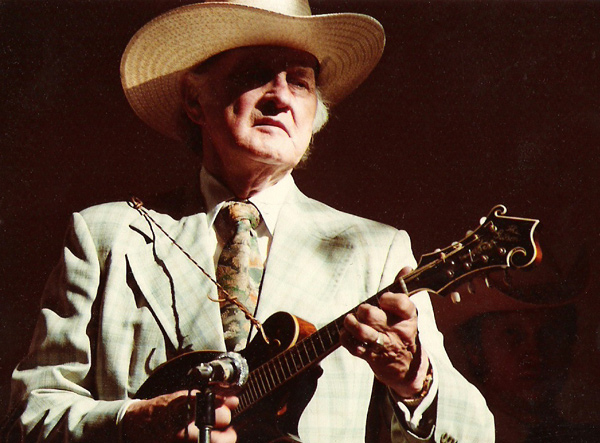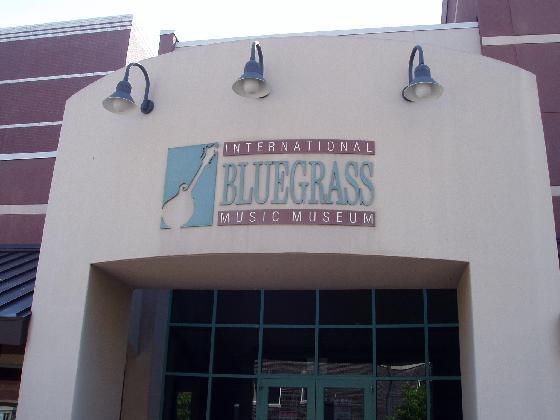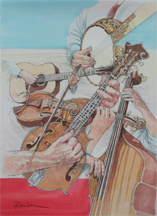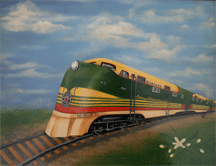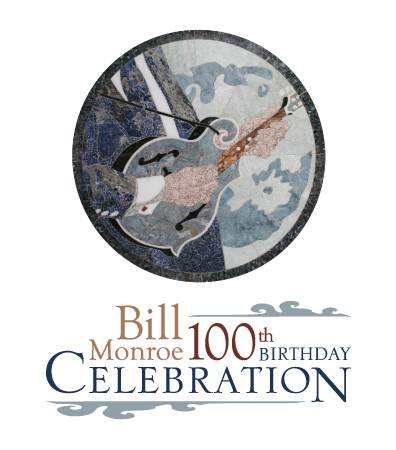A Bill Monroe Centennial Moment
High, Blue and Lonesome
A label change in 1950 and the arrival of Jimmy Martin in the Blue Grass Boys spark a period of remarkable productivity for Bill Monroe
(Ed. Note: Had he lived, Bill Monroe, the Father of Bluegrass, would be 100 years old on September 13. Mr. Bill is such a giant of American music that TheBluegrassSpecial.com is honoring his centennial year with a Bill Monroe Centennial Moment each month throughout 2011. Sometimes these will take the form of accounts of Monroe's influence on succeeding generations of musicians--as in February’s installment of how young Carl Perkins's discovery of Bill Monroe's music helped him develop the rockabilly rhythm he perfected in the honky tonks around Jackson, TN; sometimes we will look back at a signal moment in the artist's life, as we do this month in recounting how a label change in 1950, along with the arrival of Jimmy Martin in the Blue Grass Boys, sparked a period of remarkable productivity for Monroe.)
When Decca producer Paul Cohen got wind of Monroe’s rift with Columbia, he nabbed the artist for his country roster. “They shook hands in the men’s room at WSM,” said Owen Bradley, then Cohen’s assistant. Monroe didn’t ring the cash register like Ernest Tubb or Red Foley, Decca’s two powerhouse Opry acts, but his records sold steadily in the 20,000-40,000 range, more than enough to turn a profit.
The sound Monroe had nurtured was becoming a style, spreading like wildfire across country music’s Southeastern homeland and beyond. Columbia had the Stanleys and was wooing Flatt & Scruggs away from Mercury. Don Reno and Red Smiley were fronting the Tennessee Cutups, who would sign with King in 1952. Dot (Mac Wiseman), RCA (The Lonesome Pine Fiddlers) and Capitol (Jim & Jesse McReynolds) were all getting into the act. Eventually, fans would call this style bluegrass, in a nod to Monroe’s band as well as to signature songs like “Blue Grass Breakdown.” (Monroe was using the phrase “bluegrass type of music” by 1956.)
Marty Stuart and the Fabulous Superlatives perform the Bill Monroe-Hank Williams Sr. classic, ‘I’m Blue, I’m Lonesome’Early on, Monroe did not find the imitations flattering. As far as he was concerned, “bluegrass” was Bill Monroe music. Everyone else was a competitor. “Right at the beginning of it,” he said years later, “it kind put a lousy feeling in me, you know, to think anybody would be trying to copy me.” But Monroe was the last person to stand by and let others outdo him. Like the postwar country music industry, he was just getting started.
Tent shows were still going strong, and country music parks were so popular that in 1951 Monroe bought the Brown County Jamboree Barn near Bean Blossom, Indiana, and installed his brother Birch to book country talent there. At drive-in theaters--then coming into vogue--his band typically stood atop poorly lit concession stands. “They could only hear you,” said singer-guitarist Jimmy Martin, “and the only way you got a hand when you’d get through is [them] tootin’ their horns.” By 1956 Monroe was appearing on syndicated television shows filmed in Nashville and playing live telecasts like Compton, California’s popular Town Hall Party.
As usual, road shows prepared Monroe for recording. Just as he had done with Lester Flatt, he wrote many of his songs with Martin or other bandmembers as they traveled from town to town. (The extent of Monroe’s output may never be known because of the pseudonyms he used, apparently in deals with various publishers.) Songs frequently took shape in hotel rooms, in the car, or at schoolhouses where Monroe and his musicians roughed out lyrics on blackboards. ”I’d take and he’d get the mandolin,” Martin said. “The other boys would be a-pickin’. We’d set there and play the tunes to the songs, then turn around and write words. …He’d have the idea and I’d sit there and help him. …By the time he finished a new song, we’d heard it so much we already knew it.”
Performing not only provided audience feedback, but also sharpened everyone’s skills as ensemble players. At small schoolhouses, Martin said, the band often worked without microphones: “We learned to play the music so you could still hear the singer, and it taught us how to play the background to suit the voice. …That made it a lot easier to record.”
Although Monroe welcomed ideas in completing new tunes, he controlled his stage performances more closely than he had between 1946 and 1948. He continued to let some of his guitar players front the band onstage and gave sidemen their moments in the limelight, but there would be only one star--Bill Monroe. In the studio it was even clearer who was in charge, as engineer Aaron Shelton reported: “His almost shy taciturnity was occasionally broken if a musician made a mistake and a ‘retake’ was made necessary. In a clipped and sharp tone, he explained in no uncertain terms and demonstrated the correct version to the guilty sideman.”
Bill Monroe, ‘Sitting Alone in the Moonlight,’ 1954. Bill Monroe, mandolin, tenor vocal; Jimmy Martin, guitar, lead vocal; Ernie Newton, bass; Charlie Cline, fiddle; Rudy Lyle, banjo; Grady Martin, guitar. “That’s a lonesome song,’ says Jimmy Martin. ‘I guess that’s the reason why mine and Bill’s voice blends so much together. He was raised hard like I was. And when you have hard lives like that, you can put feelin’ into it.’Monroe’s sessions reflected Nashville’s growth as a recording center, a phenomenon Paul Cohen promoted in 1947 when he began using Shelton’s Castle Studio in a big way. (In 1955, Cohen backed Owen and Harold Bradley in a new studio venture--the first on Music Row--by guaranteeing them 100 sessions a year.) But the city’s nascent studio system, in which professional studio players supplemented or replaced performers’ road units, wasn’t for Bill Monroe. After experimenting with drums, piano, organ or electric guitar in three Monroe sessions held in early 1951, Decca producers left his sound alone. “It didn’t work out right,” Owen Bradley said. “It would kind of destroy his whole way of making music.” Monroe had already settled upon his ensemble approach and five-piece instrumentation, and with the exception of certain bass players and fiddlers, he would record almost exclusively with sidemen he had trained.
In retrospect, the early 1950s were years of remarkable productivity for Monroe. Many of his classic songs come from this period, and his recordings reveal him as the sun around which each new configuration of Blue Grass Boys revolved. Of course, he would continue to select songs and musical ideas he had learned since childhood, and he would build upon the ensemble style he had achieved in the late 1940s, with its driving five-string banjo, gospel quartets, high-pitched vocal solos and duets, and blues-influenced fiddling. But between 1950 and 1955, Monroe refined his sound into a form that remained essentially intact four decades later, a sound known worldwide as high lonesome. During this period Monroe’s vocals intensified, his mandolin work grew stronger and subtler, and the fiddlers he employed got bluer and better than ever, while he kept the banjo relatively restrained. As these recordings demonstrate, Monroe’s profound awareness of timing, musical dynamics, melody and harmony, and rhythm grew more acute with every passing year.
Contributing mightily to Monroe’s high lonesome sound was Jimmy Martin, whose manic energy Monroe had first set loose onstage late in 1949. Regarded by many as the best lead singer and guitarist Monroe has ever had, the Sneedville, Tennessee, country boy, then 21, could match Monroe in vocal and instrumental strength. Martin also encouraged the bandleader to sing in higher keys, as if to echo Monroe’s standing orders that musicians tune their instruments above standard pitch.
On “I’m Blue, I’m Lonesome,” a duet recorded on February 3, 1950, at Monroe’s first Decca session, Martin inspires Monroe to emphasize the angry mournfulness his voice had possessed, even though he had often sung more lyrically during the 1940s. “When I put breaks in my voice,” Martin explains, “he could put a break. That’d make his tenor sing different. …He’d always say, ‘Can you do just a little bit more of that right there?’” Their performance ably expresses the lyrics Hank Willliams Sr. wrote to Monroe’s melody while touring with Monroe and other Opry stars. Williams was speaking from experience, and so were Monroe and Martin. As Martin said of “Sitting Alone In the Moonlight,” “That’s a lonesome song. I guess that’s the reason why mine and Bill’s voice blends so much together. He was raised hard like I was. …And when you have hard lives like that, you can put feelin’ into it.”
(From John W. Rumble’s liner booklet accompanying the four-CD box set, The Music of Bill Monroe from 1936 to 1994, released in 1994)
***
Art Inspired by Bill Monroe On Exhibit and For Sale at International Bluegrass Museum
At the International Bluegrasss Museum in Owensboro, KY, now through September 15, is a display of art inspired by Bill Monroe’s music, sponsored by an Arts Build Communities grant through the Kentucky Arts Council
This Exhibit is the result of an invitation to visual artists to share their interpretation of a Bill Monroe song. Bill Monroe often painted images with his music and in this Exhibit artists have depicted their versions of these same images visually. Thirty-five artists responded to the invitation, with over sixty entries. The entries encompass many styles, from fine art to folk art. This is representative of the wide variety of people to whom Bill Monroe's music appeals.
The Old Fiddler by Frederick H. Carlson, Monroeville, PA. Inspired by ‘The Old Fiddler.’ Watercolor, graphite and gouache on Strathmore board, 10.25” x 14.” $300Most of the works of art submitted were inspired by the lyrics of a Bill Monroe song, while some were inspired by instrumentals; some were inspired by songs Monroe wrote, others by songs from other sources that Monroe covered and stamped as uniquely his.
Bringin’ My Baby Back by Laura Clementz, Spencerville, OH. Inspired by ‘Orange Blossom Special.’ Acrylic on Table, 19.5” x 15.25” x 28.25.” No price listed.The pieces of art selected for the Exhibit are listed in this catalog in alphabetical order by artist. All the art on display in the Exhibit is available for purchase at the prices listed. Sixty percent of the proceeds will go to the artist and forty percent will go to the Museum. If you are interested in purchasing any of the artwork please contact Forrest Roberts at forrest@bluegrassmuseum.org.
For more information on the Bill Monroe Centennial celebration festivities at the International Bluegrass Museum, visit the Museum website, and please make a donation to support its worthy effort to document the history and evolution of bluegrass and to promote the music to new generations.
Founder/Publisher/Editor: David McGee
Contributing Editors: Billy Altman, Laura Fissinger, Christopher Hill, Derk Richardson
Logo Design: John Mendelsohn (www.johnmendelsohn.com)
Website Design: Kieran McGee (www.kieranmcgee.com)
Staff Photographers: Audrey Harrod (Louisville, KY; www.flickr.com/audreyharrod), Alicia Zappier (New York)
E-mail: thebluegrassspecial@gmail.com
Mailing Address: David McGee, 201 W. 85 St.—5B, New York, NY 10024


